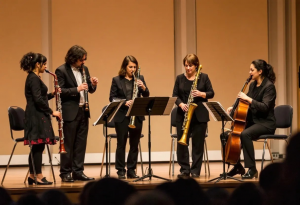Chamber music. It’s not just dusty old relics, you know? It’s alive! Constantly changing. And its future? Well, that depends on ensembles willing to take a chance. To champion fresh voices. To commission new works.
Back in the day, royalty were the big patrons. Now? It’s often the musicians themselves stepping up. They’re literally shaping the future sound of classical music.
But why is commissioning so important, anyway? Simple: it keeps chamber music relevant. Without new blood, it risks becoming a museum piece. Admired, sure, but lacking that spark to grab new listeners and inspire young musicians. Commissioning? That’s a breath of fresh air. It gives composers a stage to play with new ideas, new techniques, new sounds.
The Ensemble’s Role: A Closer Look
Take the Chione Quintet. These guys aren’t just playing the old hits. They’re actively hunting down composers, supporting them. Building a collaborative space that leads to seriously groundbreaking music.

And it’s more than just writing a check. They talk to the composer. Offer feedback. Help shape the piece to fit their unique skills and vision. This collaboration? It’s key.
It lets composers tailor their work. To the ensemble’s specific instruments and abilities. The result? A performance that’s technically spot-on and deeply moving. Plus, it creates a sense of ownership. Everyone’s invested – performers and composer alike.
More Than Just Notes: The Ripple Effect
The benefits of commissioning? They go way beyond just one new piece. Think about it:
- It sparks musical innovation. Pushes the boundaries of “chamber music.”
- It gives emerging composers a leg up. Helps them get noticed, build a career.
- And, maybe most importantly, it makes concerts exciting. Audiences get to hear something truly brand new.
And the cultural impact? Huge. Every new commission is a statement. A reflection of the times. It can dig into social issues, celebrate different cultures, or just offer a fresh take on what it means to be human. By backing today’s composers, ensembles are helping chamber music stay alive. Stay relevant.
Challenges & Opportunities
Okay, commissioning isn’t all sunshine and roses. Funding? That’s a big hurdle. Ensembles have to get creative. Hit up foundations, individual donors, government grants. And they need to be brave. Willing to invest in composers who might not be instant hits.
But the potential? Massive. Digital platforms have made connecting with composers and audiences worldwide easier than ever. Online streaming and recordings let new works reach a wider audience. Creating buzz and excitement around contemporary chamber music. Social media? A powerful tool for promoting concerts and connecting with fans.
Supporting the Future: Everyone’s Got a Role
Chamber music’s future? It’s a team effort. Composers, ensembles, audiences, funders – we all need to pull together. Create a supportive ecosystem for new music.
Here’s how you can help:
- Go to concerts!
- Donate to commissioning funds.
- Champion arts education in schools.
- Embrace the new. Celebrate diverse voices.
By investing in new works, we’re not just preserving the past. We’re shaping the future. Making sure chamber music thrives for generations.
The Composer’s Voice
I spoke with several composers who’ve been commissioned. One thing kept coming up: the power of artistic collaboration. As one composer put it, “The Chione Quintet didn’t just play my piece. They understood it. Their insights during rehearsals were invaluable. Helping me fine-tune the work, bring it to life.” That’s the kind of partnership that really matters. More than just a transaction.
Bringing in New Listeners
Another key to the future? Engaging new audiences. Think outside the box. Innovative programming. Educational outreach. Using technology to reach more people.
Some ensembles are experimenting with multimedia. Creating immersive experiences. Others are offering pre-concert talks, workshops. Giving context, insight into the music.
The Power of Music Education
Music education? It’s crucial. By introducing young people to the joy of playing and listening, we’re building a lifelong love for the art form. Schools and community groups need to prioritize music programs. Expose students to all kinds of music, including contemporary chamber works.
Looking Ahead: The Future is Bright
Commissioning new works? It’s not a trend. It’s essential. Ensembles like the Chione Quintet are leading the way. Showing the power of collaboration, innovation, and supporting today’s composers. By embracing new music and engaging new audiences, we can ensure chamber music stays vibrant and relevant. For years to come.

